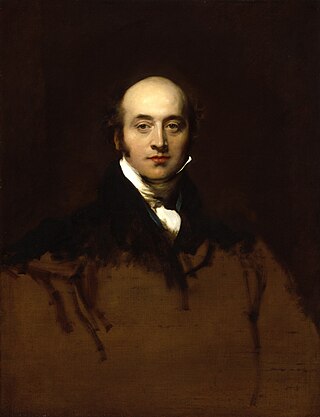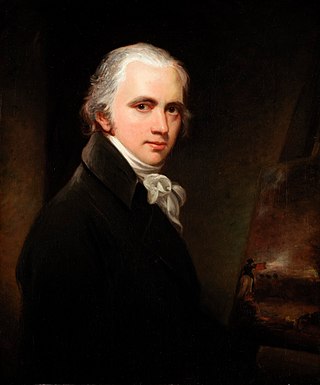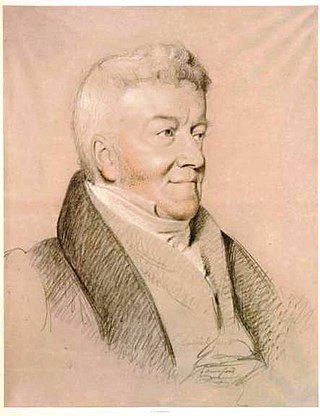Related Research Articles

Sir Thomas Lawrence was an English portrait painter and the fourth president of the Royal Academy. A child prodigy, he was born in Bristol and began drawing in Devizes, where his father was an innkeeper at the Bear Hotel in the Market Square. At age ten, having moved to Bath, he was supporting his family with his pastel portraits. At 18, he went to London and soon established his reputation as a portrait painter in oils, receiving his first royal commission, a portrait of Queen Charlotte, in 1789. He stayed at the top of his profession until his death, aged 60, in 1830.

Henry Fuseli was a Swiss painter, draughtsman, and writer on art who spent much of his life in Britain. Many of his works depict supernatural experiences, such as The Nightmare. He painted works for John Boydell's Shakespeare Gallery and created his own "Milton Gallery". He held the posts of Professor of Painting and Keeper at the Royal Academy. His style had a considerable influence on many younger British artists, including William Blake.

Sir David Wilkie was a Scottish painter, especially known for his genre scenes. He painted successfully in a wide variety of genres, including historical scenes, portraits, including formal royal ones, and scenes from his travels to Europe and the Middle East. His main base was in London, but he died and was buried at sea, off Gibraltar, returning from his first trip to the Middle East. He was sometimes known as the "people's painter".

Benjamin West, was a British-American artist who painted famous historical scenes such as The Death of Nelson, The Death of General Wolfe, the Treaty of Paris, and Benjamin Franklin Drawing Electricity from the Sky.

Sir George Hayter was an English painter, specialising in portraits and large works involving sometimes several hundred individual portraits. Queen Victoria appreciated his merits and appointed Hayter her Principal Painter in Ordinary and also awarded him a Knighthood in 1841.

John Keyse Sherwin was an English engraver and history-painter.

Sir William Beechey was a British portraitist during the golden age of British painting.

George Richmond was an English painter and portraitist. In his youth he was a member of The Ancients, a group of followers of William Blake. Later in life he established a career as a portrait painter, which included painting the portraits of the British gentry, nobility and royalty.

Ellen Wallace Sharples was an English painter specialized in portraits in pastel and in watercolor miniatures on ivory. She exhibited five miniatures at the Royal Academy in 1807, and founded the Bristol Fine Arts Academy in 1844 with a substantial gift.
The Havell family of Reading, Berkshire, England, included a number of notable engravers, etchers and painters, as well as writers, publishers, educators, and musicians. In particular, members of this family were among the foremost practitioners of aquatint; and had a long association with Indian art and culture. The family first came to notice through the brothers Luke Havell and Robert Havell the Elder ; along with their nephew Daniel Havell.

Philip Reinagle was an English painter of animals, landscapes, and botanical scenes. The son of a Hungarian musician living in Edinburgh, Reinagle came to London in 1763 and after serving an apprenticeship, later became a member of the Royal Academy.

Thomas Landseer was a British artist best known for his engravings and etchings, particularly those of paintings by his youngest brother Edwin Landseer.

Edward Edwards was an English painter and etcher. He held the post of Professor of Perspective at the Royal Academy, and compiled a book entitled Anecdotes of Painters (1808).

John Comerford was an Irish miniature painter active in Kilkenny and Dublin. He exhibited in London at the Royal Academy in 1804 and 1809.
William Derby (1786–1847) was an English portraitist, miniature painter and copyist.

Richard Evans (1784–1871), was an English portrait-painter and copyist, a pupil and later assistant of Sir Thomas Lawrence.

Johann or John Eckstein (1735–1817), was a German-born sculptor, engraver and painter who worked briefly in London before establishing himself in his homeland and then in America. He is not to be confused with his son, also known as John, a painter who worked in England and the West Indies.

Joseph Wright was an American portrait painter and sculptor. He painted life portraits of George Washington and Benjamin Franklin, and was a designer of early U.S. coinage. Wright was President Washington's original choice for Chief Engraver of the U.S. Mint, but died at age 37, before being confirmed to that position.

William Bell was an English painter who specialised in portraits. A prize-winning student at the Royal Academy of Arts, influenced by Sir Joshua Reynolds, he achieved eminence in his native area, the North East of England. His best-known works are portraits of Sir John Delaval and his family, which are in the collection of the National Trust at Seaton Delaval Hall, Northumberland. Bell's portrait of Robert Harrison, 1715–1802, is in the collection of the National Portrait Gallery, London.

Friedrich Wilhelm Ternite was a German portrait painter, miniaturist and lithographer. In Berlin, he served as a court painter and inspector of the Royal Art Gallery.
References
![]() This article incorporates text from a publication now in the public domain : Cust, Lionel Henry (1888). "Davy, Robert". In Stephen, Leslie (ed.). Dictionary of National Biography . Vol. 14. London: Smith, Elder & Co.
This article incorporates text from a publication now in the public domain : Cust, Lionel Henry (1888). "Davy, Robert". In Stephen, Leslie (ed.). Dictionary of National Biography . Vol. 14. London: Smith, Elder & Co.